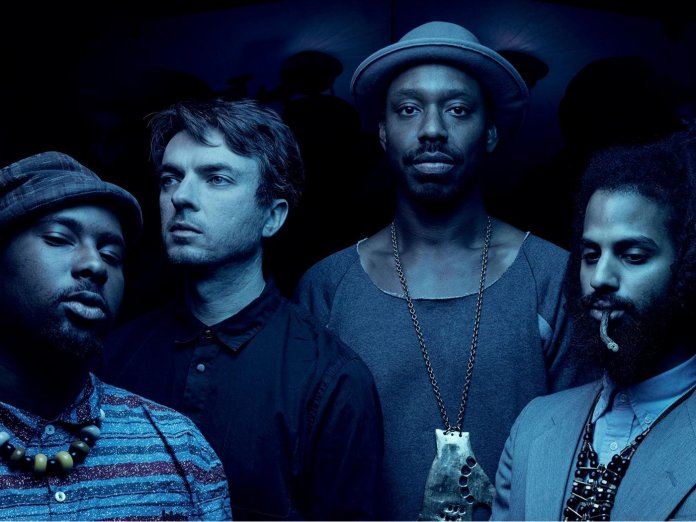The tuk-band is not one of the Caribbean’s more famous musical exports, but it is a relatively common sight at carnivals around Barbados, the island where Sons Of Kemet leader Shabaka Hutchings spent much of his childhood. It is a marching band featuring snare drums, bass drums and triangles, fronted by one or two flutes playing military-style riffs and melodies. During festivals, tuk-bands are accompanied by dancing costumed figures – the Shaggy Bear, the Donkey Man, a man in drag called Mother Sally, and another man on stilts. What seems like a joyous, celebratory music actually has darker roots – it stems back to the establishment of plantations in the 17th century, when enslaved Africans were banned from using drums for fear they might use them to incite rebellions. So the islanders would imitate British military music, disguising ancient African rituals in a syncretic form that colonial authorities would not take offence at.
- ORDER NOW: The July 2021 issue of Uncut
Over the last decade and four Sons Of Kemet albums, Shabaka Hutchings has taken this obscure Barbadian tradition and delved deep into its history, uncovering its subversive roots and plunging them way into the future, adding touches of dub, calypso and Afrobeat. In the hands of Hutchings, the tuk-band is a barely suppressed howl of rage, a clamorous carnival of protest. Sons Of Kemet’s last album, 2018’s Mercury-nominated Your Queen Is A Reptile, was an implicit attack on the notion of royalty, poking fun at the idea that birthright should define class and status. Now Black To The Future chimes with the spirit of the BLM movement that reached a crescendo in summer 2020, but – interestingly – the LP was done and dusted in May 2019.
“Black is tired,” sighs the poet Joshua Idehen on the final track, “Black”. “Black would like to make a statement. Black’s eyes are vacant, Black’s arms are leaden, Black’s tongue cannot taste shit.” As the backing music builds into a demented 5/8 chant, his poem gets angrier. “Black demands that no person who is trigger nervous deserves a gun, much less a badge. Black knows that one day its arms will be up, but its shadow will be reaching for something that isn’t there, but that will be enough.”
Some of the guest vocalists on this LP approach this level of militancy but, in places, Black To The Future is also poppier and more dancefloor friendly than anything Hutchings has ever released. “Hustle”, featuring a baritone-voice chant from rapper/poet Kojey Radical and sweet backing vocals from Lianne Le Havas, is a one-chord Afrobeat jam that would fit comfortably onto the BBC 1Xtra playlist. “For The Culture” is an upbeat, clattering piece of neo-soca featuring grime MC D Double E and some sweet horn harmonies.
On several tracks, like “Throughout The Madness, Stay Strong” and “In Remembrance Of Those Fallen”, Hutchings also overdubs various flutes and penny whistles to recreate the flute feel of the classic tuk-band, but here the riffs he plays are angular, chromatic, and slightly disorientating. They remind us of the parallels between the tuk-band and other related music from around the African diaspora – in particular those pennywhistle-led mento bands from Jamaica, or the African-American fife-and-drum combos from Mississippi (which sound like weirdly funky Loyalist marching bands). Effectively, Sons Of Kemet reimagines a world in which jazz might have sprung from the Caribbean rather than New Orleans. “Envision Yourself Levitating” is a remarkable example of this – a piece of freaky astral improvisation (featuring fellow tenor saxophonist Kebbi Williams) set to a mournful nyabinghi dub rhythm.
It can’t be stressed enough quite how significantly this new generation of British jazz musicians have succeeded in “de-Americanising” jazz. Trained at jazz conservatoires, they know their bebop and swing history backwards, but rarely choose to play in that vernacular. And Hutchings – who actually trained as a classical clarinet player, rather than a jazz saxophonist – is possibly the least American-sounding of the lot. He rarely bends his notes or plays “blues” scales – a staple of US jazz and R&B – instead his solos tend to use the distinctive modal scales you get in Ethiopian music. Sometimes his playing is more like a drummer or a rapper – he will blow percussive, syncopated rhythms based around one or two notes, often tonguing his reed to interlock with the hi-hats. Here his solos tend to be simple, forthright chants, using repetition. There is a curious militancy in his playing, which can be hectoring but also quite rhythmically compelling. It doesn’t demand love or affection. It increases your heart rate and forces you onto the dancefloor. And it’s taking Sons Of Kemet in a direction that is both more militant and more populist.



